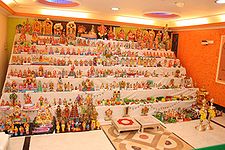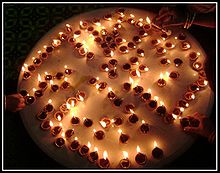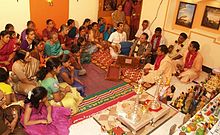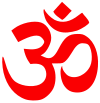- Navratri
-
For the Indian film, see Navarathri (1966 film).
Navaratri 
Navratri Golu depicting various forms of Hindu deities worshiped for 9 daysType Major [Hindu] Festival. Begins September/October Ends October/November Date Usually Sept-November. The date changes as per lunar calender. 2010 date October 8 - October 16 2011 date September 28 - October 6 Celebrations 9-10 days Navratri, Navaratri, or Navarathri (Hindi: नवरात्रि; Gujarati: નવરાત્રી; Tamil: நவராத்திரி; Sanskrit: नवरात्रम्; Marathi: नवरात्र; Nepali: नवरात्रि; Bengali: নবরাত্রি; Kannada: ನವರಾತ್ರಿ; Telugu: దుర్గా నవరాత్రులు; Malayalam: നവരാത്രി) is a Hindu festival of worship of Shakti and dance & festivities. The word Navaratri literally means nine nights in Sanskrit, nava meaning nine and ratri meaning nights. During these nine nights and ten days, nine forms of Shakti/Devi are worshiped. The 10th day is commonly referred to as Vijayadashami or Dussehra.
Contents
Significance
The beginning of spring and the beginning of autumn are two very important junctions of climatic and solar influence. These two periods are taken as sacred opportunities for the worship of the Divine Mother. The dates of the festival are determined according to the lunar calendar.
Navaratri represents celebration of Goddess Durga, the manifestation of Deity in form of Shakti [Energy or Power]. The Navaratri festival or ‘Nine Nights festival’ becomes ‘ten days festival’ with the addition of the last day, Vijayadashami which is its culmination. On all these ten days, the various forms of Mother Mahisasura-mardini (Durga) are worshipped with fervor and devotion. [1]
 Devotees in West Bengal diya lamps to celebrate Navaratri and Durga Puja
Devotees in West Bengal diya lamps to celebrate Navaratri and Durga Puja Practices
PracticesNavaratri is celebrated five times a year. They are Vasanta Navaratri, Ashadha Navaratri, the Sharada Navaratri, and the Paush/Magha Navaratri. Of these, the Sharada Navaratri of the month of Puratashi and the Vasanta Navaratri of the Vasanta kala are very important.
1. Vasanta Navaratri: Basanta Navrathri, also known as Vasant Navratras, is the festival of nine days dedicated to the nine forms of Shakti (Mother Goddess) in the spring season (March–April). It is also known as Chaitra Navratra. The nine days of festival is also known as Raama Navratri.
2. Gupta Navaratri: Gupta Navratri, also referred as Ashadha or Gayatri or Shakambhari Navratri, is nine days dedicated to the nine forms of Shakti (Mother Goddess) in the month of Ashadha (June–July). Gupta Navaratri is observed during the Ashadha Shukla Paksha (waxing phase of moon).
3. Sharada Navaratri: This is the most important of the Navratris. It is simply called Maha Navratri (the Great Navratri) and is celebrated in the month of Ashvina. Also known as Sharad Navaratri, as it is celebrated during Sharad (beginning of winter, September–October).
4. Paush Navaratri: Paush Navratri is nine days dedicated to the nine forms of Shakti (Mother Goddess) in the month of Paush (December–January). Paush Navaratri is observed during the Paush Shukla Paksha (waxing phase of moon).
5. Magha Navaratri: Magha Navratri, also referred as Gupta Navratri, is nine days dedicated to the nine forms of Shakti (Mother Goddess) in the month of Magha (January–February). Magha Navaratri is observed during the Magha Shukla Paksha (waxing phase of moon).
This is celebrated during Vasanta Rhitu (beginning of summer) (March- April). This is also known as Chaitra navaratri as it falls during the lunar month of Chaitra.
In days long gone by, King Dhruvasindhu was killed by a lion when he went out hunting. Preparations were made to crown the prince Sudarsana. But, King Yudhajit of Ujjain, the father of Queen Lilavati, and King Virasena of Kalinga, the father of Queen Manorama, were each desirous of securing the Kosala throne for their respective grandsons. They fought with each other. King Virasena was killed in the battle. Manorama fled to the forest with Prince Sudarsana and a eunuch. They took refuge in the hermitage of Rishi Bharadwaja.
The victor, King Yudhajit, thereupon crowned his grandson, Satrujit, at Ayodhya, the capital of Kosala. He then went out in search of Manorama and her son. The Rishi said that he would not give up those who had sought protection under him. Yudhajit became furious. He wanted to attack the Rishi. But, his minister told him about the truth of the Rishi’s statement. Yudhajit returned to his capital.
Fortune smiled on Prince Sudarsana. A hermit’s son came one day and called the eunuch by his Sanskrit name Kleeba. The prince caught the first syllable Kli and began to pronounce it as Kleem. This syllable happened to be a powerful, sacred Mantra. It is the Bija Akshara (root syllable) of the Divine Mother. The Prince obtained peace of mind and the Grace of the Divine Mother by the repeated utterance of this syllable. Devi appeared to him, blessed him and granted him divine weapons and an inexhaustible quiver.
The emissaries of the king of Benares passed through the Ashram of the Rishi and, when they saw the noble prince Sudarsana, they recommended him to Princess Sashikala, the daughter of the king of Benares.
The ceremony at which the princess was to choose her spouse was arranged. Sashikala at once chose Sudarsana. They were duly wedded. King Yudhajit, who had been present at the function, began to fight with the king of Benares. Devis helped Sudarsana and his father-in-law. Yudhajit mocked Her, upon which Devi promptly reduced Yudhajit and his army to ashes.
Thus Sudarsana, with his wife and his father-in-law, praised Devi. She was highly pleased and ordered them to worship her with havan and other means during the Vasanta Navaratri. Then she disappeared.
Prince Sudarsana and Sashikala returned to the Ashram of Rishi Bharadwaja. The great Rishi blessed them and crowned Sudarsana as the king of Kosala. Sudarsana and Sashikala and the king of Benares implicitly carried out the commands of the Divine Mother and performed worship in a splendid manner during the Vasanta Navaratri.
Sudarsana’s descendants, namely, Sri Rama and Lakshmana, also performed worship of Devi during the Sharada Navaratri and were blessed with Her assistance in the recovery of Sita.
Commences on the first and ends on the tenth day of the bright half of the lunar month Aswayuja/Asvina.
‘The Navaratri festival has to be celebrated during the bright fortnight of the month of Asvina, in the order of pratipada, etc, until the navami ends,’ says the Dhaumya-vacana.
Navaratri in the year 2011 starts on 28 September 2011 and ends on 05 October 2011 with Vijayadashami celebrated on 06 October 2011.
Forms of Shakti
Main article: NavadurgaNine forms of Shakti are worshipped during the Navaratris. The Devis worshipped depend on the tradition of the region.
- Durga, the inaccessible one
- Bhadrakali
- Amba or Jagadamba, Mother of the universe
- Annapoorna devi, The one who bestows grains (anna) in plenty (purna: used as subjective)
- Sarvamangala, The one who gives joy (mangal) to all (sarva)
- Bhairavi
- Chandika or Chandi
- Lalita
- Bhavani
- Mookambika
Rituals
 Garba dance in Ahmedabad during navratri festivities
Garba dance in Ahmedabad during navratri festivities
The Navratri commences on the first day (pratipada) of the bright fortnight of the lunar month of Ashvin. The festival is celebrated for nine nights once every year during the beginning of October, although as the dates of the festival are determined according to the lunar calendar, the festival may be held for a day more or a day less.
Navaratri is celebrated in different ways throughout India. In North India, all three Navratris are celebrated with much fervor by fasting on all nine days and worshipping the Mother Goddess in her different forms. The Chaitra Navratri culminates in Ram Navami and the Sharad Navratri culminates in Durga Puja and Dussehra. The Dussehra of Kullu in Himachal Pradesh is particularly famous in the North. Navratri festival in Gujarat is one of the main festivals. Garba is dance which people use to dance after the Durga Pooja with the groups and live orchestra or devotional songs.
The last four days of Sharad Navratri take on a particularly dramatic form in the states of Bihar,Jharkhand,West Bengal,Orissa,Assam in East India where they are celebrated as Durga Puja.[2] This is the biggest festival of the year in this state. Exquisitely crafted and decorated life-size clay idols of the Goddess Durga depicting her slaying the demon Mahishasura are set up in temples and other places. These idols are then worshipped for five days and immersed in the river on the fifth day.
In Western India, particularly in the state of Gujarat, Navratri is celebrated with the famous Garba and Dandiya-Raas dance. Since the past few years, the Government Of Gujarat has been organising the "Navratri Festival Celebrations" on a regular basis for the nine days of Navratri Festival in Gujarat. People from all over Gujarat and even abroad come to participate in the nine days celebrations. It is also popular throughout India and among Indian communities around the world including the UK, Canada and USA.
In Goa, zatra begins during Navratri, entire Antruz (Ponda) is highly ornated. The Saraswat Brahmin temples are beautifully decorated and the idols are taken out for worship. The idols are dressed and adorned with flowers, sandalwood paste, turmeric and kumkum. Devotees come during Navaratri to get the special darshan and what mostly a devotee awaits is the Kaul Prasad, which is as something given from the Gods and Goddess itself. The Deities are emblazoned with flowers and devotees or priests continue to worship the deity without even changing the flowers on them. At the end of the festive night the flowers are distributed as Prasad for the devotees. The Dasha Maitrikas (the 10 sisters of Goa) of the Saraswat Brahmins are taken out to worship - namely, Shantadurga, Aryadurga, Mahalasa, Katyayani, Mahamaya, Kamakshi, Vijayadurga, Bhumika, Mahalakshmi and Navadurga.
In South India, people set up steps and place idols on them. This is known as golu. Photos of typical Golu displayed in Tamil Nadu style at a home in Nerul, Navi Mumbai, Maharashtra, India is shown by the side.
In Karnataka, Ayudha Puja, the ninth day of Mysore Dasara, is celebrated with the worship of implements used in daily life such as computers, books, vehicles, or kitchen tools. The effort to see the divine in the tools and objects one uses in daily life is central to this celebration, so it includes all tools that help one earn one's livelihood. Knowledge workers go for books, pen or computers, farmers go for the plough and other agricultural tools, machinery for industrialists and cars/buses/trucks for the transportation workers—all are decorated with flowers and worshipped on this day invoking God's blessing for success in coming years. It is believed that any new venture such as starting of business or purchasing of new household items on this day is bound to bring success and properity.
In Kerala, three days: Ashtami, Navami, and Vijaya Dashami of Sharad Navaratri are celebrated as Sarasvati Puja in which books are worshipped. The books are placed for Puja on the Ashtami day in own houses, traditional nursery schools, or in temples. On Vijaya Dashami day, the books are ceremoniously taken out for reading and writing after worshipping Sarasvati. Vijaya Dashami day is considered auspicious for initiating the children into writing and reading, which is called Vidyarambham. Tens of thousands of children are initiated into the world of letters on this day in Kerala.
In Telangana region of Andhra Pradesh, people celebrate Bathukamma festival over a period of nine days. It is a kind of navratri celebration.
Navratri is divided into sets of three days to adore three different aspects of the supreme goddess or goddesses.
First three days
The goddess is separated as a spiritual force called Durga also known as Kali in order to destroy all our impurities.
Second three days
The Mother is adored as a giver of spiritual wealth, Lakshmi, who is considered to have the power of bestowing on her devotees inexhaustible wealth, as she is the goddess of wealth.
Final three days
The final set of three days is spent in worshipping the goddess of wisdom, Saraswati. In order to have all-round success in life, believers seek the blessings of all three aspects of the divine femininity, hence the nine nights of worship.
Eighth day is traditionally Durgashtami which is big in Bengal.
In some parts of South India, Saraswati puja is performed on the 9th day. Ayudha Puja is conducted in many parts of South India on the Mahanavami (Ninth) day with much fanfare. Weapons, agricultural implements, all kinds of tools, equipments, machinery and automobiles are decorated and worshipped on this day along with the worship of Goddess. The work starts afresh from the next day, i.e. the 10th day which is celebrated as 'Vijaya Dashami'. Many teachers/Schools in south India start teaching Kindergarten children from that day onwards.
In North India, as the culmination of the Ramlila which is enacted ceremoniously during Dussehra, the effigies of Ravana, Kumbhakarna, and Meghanada are burnt to celebrate the victory of good (Rama) over evil forces on the 'Vijaya Dashami' day.
During Navratri, some devotees of Durga observe a fast and prayers are offered for the protection of health and prosperity. Devotees avoid meat, alcoholic drinks, grains, wheat and onion during this fast. Grains are usually avoided since it is believed that during the period of Navratri and seasonal change, grains attract and absorb lots of negative energies[3] from the surrounding and therefore there is a need to avoid eating anything which are produced from grains for the purification of Navratri to be successful. Navratri is also a period of introspection and purification, and is traditionally an auspicious and religious time for starting new ventures.
During this vowed religious observance, a pot is installed (ghatasthapana) at a sanctified place at home. A lamp is kept lit in the pot for nine days. The pot symbolizes the universe. The uninterrupted lit lamp is the medium through which we worship the effulgent Adishakti, i.e. Sree Durgadevi. During Navratri, the principle of Sree Durgadevi is more active in the atmosphere.
Navratri is celebrated in a large number of Indian communities. The mother goddess is said to appear in 9 forms, and each one is worshipped for a day. These nine forms signify various traits that the goddess influences us with. The Devi Mahatmya and other texts invoking the Goddess who vanquished demons are cited.
During the eight or ninth day, Kanya Poojan, pre-pubescent girls are ceremonially worshiped.
See also
References
External links
- Navaratri: In the festival of "Nine Nights," Hindus across the globe worship the feminine form of the Supreme
- How to worship the Goddess during Navratri ?
Festivals in the Hindu calendar Major festivals - Pongal (Makar Sankranti)
- Holi
- Rama Navami
- Krishna Janmashtami
- Maha Shivaratri
- Onam
- Ganesh Chaturthi
- Navratri (Mysore Dasara – Durga Puja – Vijayadashami)
- Diwali (Bhau-Beej)
- Chhath
- Vat Purnima

Regional New Year - Gudi Padwa (Marathi, Konkani)
- Ugadi (Telugu, Kannada)
- Cheti Chand (Sindhi)
- Bihu (Assamese)
- Vaisakhi (Punjabi)
- Vishuva Sankranti (Oriya)
- Pohela Boishakh (Bengali)
- Puthandu (Tamil)
- Vishu (Malayalee)
Holy days Holy periods Categories:- Hindu festivals
- Festivals in India
- Festivals in Nepal
- Gujarati culture
Wikimedia Foundation. 2010.





